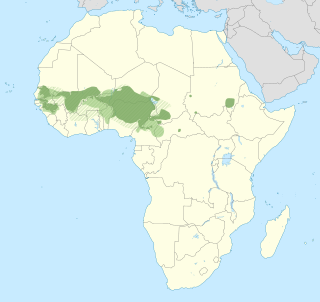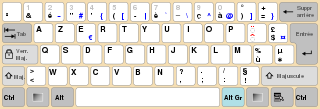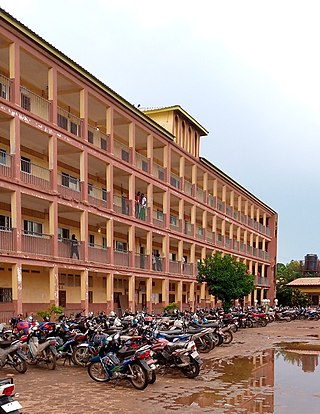Related Research Articles

Dyula is a language of the Mande language family spoken mainly in Burkina Faso, Ivory Coast and Mali, and also in some other countries, including Ghana, Guinea and Guinea-Bissau. It is one of the Manding languages and is most closely related to Bambara, being mutually intelligible with Bambara as well as Malinke. It is a trade language in West Africa and is spoken by millions of people, either as a first or second language. Similar to the other Mande languages, it uses tones. It may be written in the Latin, Arabic or N'Ko scripts.

Conakry is the capital and largest city of Guinea. A port city, it serves as the economic, financial and cultural centre of Guinea. Its population as of the 2014 Guinea census was 1,660,973.

Ahmed Sékou Touré was a Guinean political leader and African statesman who became the first president of Guinea, serving from 1958 until his death in 1984. Touré was among the primary Guinean nationalists involved in gaining independence of the country from France. He would later die in the United States in 1984.
Maore Comorian, or Shimaore, is one of the two indigenous languages spoken in the French-ruled Comorian islands of Mayotte; Shimaore being a dialect of the Comorian language, while ShiBushi is an unrelated Malayo-Polynesian language originally from Madagascar. Historically, Shimaore- and ShiBushi-speaking villages on Mayotte have been clearly identified, but Shimaore tends to be the de facto indigenous lingua franca in everyday life, because of the larger Shimaore-speaking population. Only Shimaore is represented on the local television news program by Mayotte La Première. The 2002 census references 80,140 speakers of Shimaore in Mayotte itself, to which one would have to add people living outside the island, mostly in metropolitan France. There are also 20,000 speakers of Comorian in Madagascar, of which 3,000 are Shimaore speakers.

Pulaar is a Fula language spoken primarily as a first language by the Fula and Toucouleur peoples in the Senegal River valley area traditionally known as Futa Tooro and further south and east. Pulaar speakers, known as Haalpulaar'en live in Senegal, Mauritania, the Gambia, and western Mali. The two main speakers of Pulaar are the Toucouleur people and the Fulɓe. Pulaar is the second most spoken local language in Senegal, being a first language for around 22% of the population. This correlates with 23.7% of the country in which Pulaar is the population's ethnicity. Pulaar is one of the national languages of Senegal alongside 13 others. It was admitted as an official language of Senegal by Presidential decree in 1971. There are around 28 known dialects of Pulaar, most of which are mutually intelligible with each other. The Pulaar dialects, as well as other West African languages, are usually referenced under the umbrella term ‘Fula’. Pulaar as a language, however, is not usually referenced as ‘Fula’.
French orthography encompasses the spelling and punctuation of the French language. It is based on a combination of phonemic and historical principles. The spelling of words is largely based on the pronunciation of Old French c. 1100–1200 AD, and has stayed more or less the same since then, despite enormous changes to the pronunciation of the language in the intervening years. Even in the late 17th century, with the publication of the first French dictionary by the Académie française, there were attempts to reform French orthography.
Djibril Tamsir Niane was a Guinean historian, playwright, and short story writer.
The romanization of Macedonian is the transliteration of text in Macedonian from the Macedonian Cyrillic alphabet into the Latin alphabet. Romanization can be used for various purposes, such as rendering of proper names in foreign contexts, or for informal writing of Macedonian in environments where Cyrillic is not easily available. Official use of romanization by North Macedonia's authorities is found, for instance, on road signage and in passports. Several different codified standards of transliteration currently exist and there is widespread variability in practice.
Serer, often broken into differing regional dialects such as Serer-Sine and Serer saloum, is a language of the Senegambian branch of the Niger–Congo family spoken by 1.2 million people in Senegal and 30,000 in the Gambia as of 2009. It is the principal language of the Serer people, and was the language of the early modern kingdoms of Sine, Saloum, and Baol.

Pular (𞤆𞤵𞤤𞤢𞤪) is a Fula language spoken primarily by the Fula people of Fouta Djallon, Guinea. It is also spoken in parts of Guinea-Bissau, Sierra Leone, and Senegal. There are a small number of speakers in Mali. Pular is spoken by 4.3 million Guineans, about 55% of the national population. This makes Pular the most widely spoken indigenous language in the country. Substantial numbers of Pular speakers have migrated to other countries in West Africa, notably Senegal.

Wolofal is a derivation of the Arabic script for writing the Wolof language. It is basically the name of a West African Ajami script as used for that language.

Saifoulaye Diallo was a Guinean politician, lawmaker and cabinet member.
The Fula language is written primarily in the Latin script, but in some areas is still written in an older Arabic script called the Ajami script or in the recently invented Adlam script.

Kabiné Komara was Prime Minister of Guinea from 30 December 2008 to 26 January 2010. Until the end of 2008 a director at the African Export-Import Bank in Cairo, Egypt, Komara was announced as the new Prime Minister in a government radio broadcast on 30 December.

The Republic of Guinea is a multilingual country, with over 40 languages spoken. The official language is French, which was inherited from colonial rule.
Trade unions in Guinea were historically important - having played a pivotal role in the country's independence movement - and in recent years have again assumed a leading role.

Julius Nyerere University of Kankan (UJNK), also known as Université de Kankan is a university in Kankan, Guinea. It is named after Julius Nyerere, the first President of Tanzania.
First lady of Guinea is the title attributed to the wife of the president of Guinea. The country's present first lady is Lauriane Doumbouya, wife of interim President Mamady Doumbouya, who had held the position since the 2021 Guinean coup d'etat on September 5, 2021. There has been no first gentleman of Guinea to date.
Kaba Rougui Barry was a Guinean politician and entrepreneur.
References
- ↑ Gilbert Sâa Ifono, "L'activité terminologique en Guinée," RINT 9, June 1993 Archived 2014-12-05 at the Wayback Machine
- ↑ Diallo, Alpha Mamadou, Usages et images des langues en guinée, Université de Conakry.
- ↑ Diallo, Amadou; Étude sur le rôle de l'éducation non formelle dans la stratégie de réduction de la pauvreté (SRP) en Guinée, Ministère du Plan de la République de Guinée/ GTZ, Conakry 3/2006. Archived 2011-07-28 at the Wayback Machine
- ↑ Effectuated by decree 019/PRG/SGG/89
- Académie des langues, République de Guinée (1976). Alphabet national des langues de la République de Guinée.